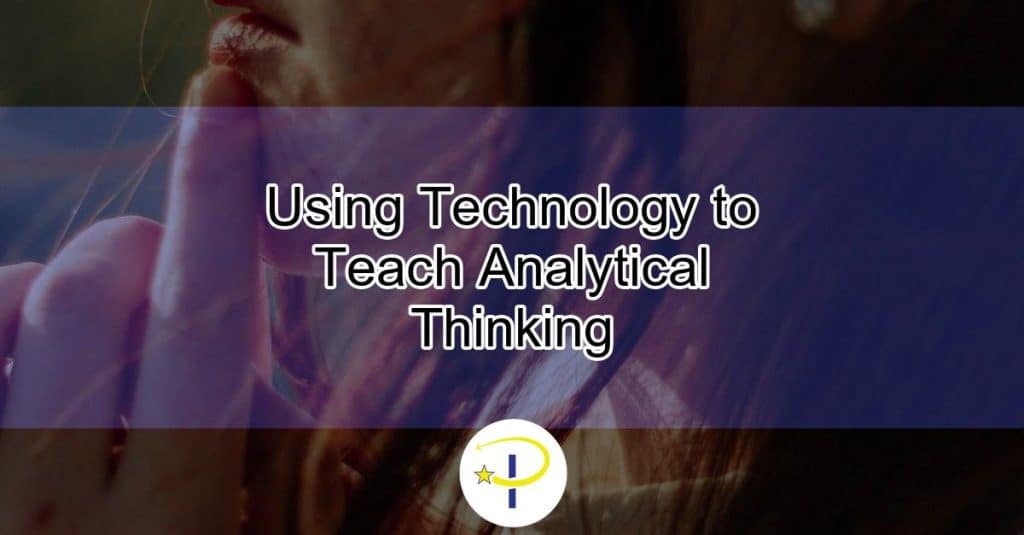Using Technology to Teach Analytical Thinking
Analytical thinking is a vital skill that is rapidly gaining significance in the modern world. As we are entering a new era of information and technology, the ability to analyze complex situations and make informed decisions based on the available data is essential. In this context, educational institutions and teachers need to focus on developing and enhancing analytical thinking skills among their students.
One of the most effective ways of achieving this objective is through the use of technology in teaching. Technology offers various tools and resources that can be leveraged to facilitate the development of analytical thinking skills among the students. In this article, we will explore the various ways in which technology can help to improve analytical thinking abilities in the classroom.
What is Analytical Thinking and Why is it Important?
Defining analytical thinking
Analytical thinking involves the ability to break down complex information, identify patterns, and draw conclusions through critical thinking and problem-solving skills. It is important in both personal and professional aspects of life.
The importance of analytical thinking skills in the 21st century
Analytical thinking skills are essential in the current era of vast amounts of data and information. Employers seek individuals who possess the ability to evaluate and analyze data to make informed decisions, as it can be applied to various roles and industries.
How Can Technology Enhance Analytical Thinking Skills?
Technology has the potential to greatly enhance analytical thinking skills in education. Software like Microsoft Excel, Tableau, and SPSS can be used for data analysis, while virtual simulations and modeling tools like Mursion and Simulab can create real-life scenarios for critical thinking and decision-making. Case studies can also showcase successful practices and provide guidance, but it is important to implement training and support for educators in incorporating technology effectively.
How Can Technology Enhance Analytical Thinking Skills?
Technology tools for data analysis
Technology can provide numerous tools for data analysis that enhance analytical thinking skills. These tools include software programs that help students organize, analyze, and visualize data in a meaningful way. For example, Microsoft Excel, Tableau, and Google Analytics are all powerful data analysis tools that can help students develop their analytical skills. By using these tools, students can practice critical thinking, data interpretation, and problem solving in a real-world context.
Virtual simulations and modeling for problem-solving
Virtual simulations and modeling provide an interactive, immersive learning experience that can enhance analytical thinking skills in students. These simulations can simulate real-world scenarios, where students can practice and develop their problem-solving skills. For example, a virtual model of a manufacturing plant can help students understand how to optimize production processes, or a virtual physics lab can teach students how to apply analytical thinking to experiment design and data interpretation.
Case Studies: Best Practices for Incorporating Technology into Analytical Thinking Instruction
Case studies can highlight best practices for using technology to teach analytical thinking skills in the classroom. These case studies can provide examples of how technology has been successfully integrated into analytical thinking instruction, including the use of data analysis tools, virtual simulations, and other interactive learning experiences. By studying successful cases, educators can learn how to apply these strategies in their own classrooms and adapt them to fit their specific teaching needs.
Successful application of technology in teaching analytical thinking
The successful application of technology in teaching analytical thinking skills depends on several factors. First, it is important to identify the appropriate technology tools and resources that are best suited to meet specific learning objectives. Second, educators must properly integrate these tools into the curriculum and provide clear instruction on how to use them effectively. Third, educators must foster an environment that encourages collaboration and experimentation, allowing students to practice critical thinking and problem-solving skills in a supportive setting.
Challenges and solutions in implementing technology-based analytical thinking exercises
There are several challenges to implementing technology-based analytical thinking exercises in the classroom. These include a lack of resources, limited teacher training, and resistance from students who may be uncomfortable with new technology. To successfully implement these exercises, educators must identify and address these challenges. They can do this by securing funding for technology resources, providing relevant teacher training, and offering support and guidance to students as they learn to use new technology tools. Additionally, educators must communicate the importance and relevance of technology-based analytical thinking exercises to students, to motivate them to engage with and learn from these exercises.
In conclusion, technology can enhance analytical thinking skills in students by providing data analysis tools, virtual simulations, and other interactive learning experiences. By studying successful cases, educators can identify best practices for integrating technology into analytical thinking instruction. To successfully implement technology-based analytical thinking exercises, educators must identify and address the challenges associated with this approach, and create a supportive learning environment that encourages collaboration and experimentation.
Case Studies: Best Practices for Incorporating Technology into Analytical Thinking Instruction
Successful Application of Technology in Teaching Analytical Thinking
Nowadays, technology is an essential tool in teaching analytical thinking skills to students. By using digital resources, instructors can enhance the learning experience and provide students with engaging and interactive learning environments. Many teachers use free online collaboration resources, such as Google and Strawpoll, to survey classmates, analyze data, and draw conclusions. Additionally, gamification can reinforce learning by using games to increase student motivation and enhance independent information acquisition.
The use of technology also allows for learning beyond the classroom. Students can work remotely, as a team, to collect data or use virtual and augmented reality. Digital technologies enable the creation of interactive learning environments that offer a range of learning styles for the students. These tools allow students to learn critical thinking skills in a multisensory environment that improves engagement and academic performance.
Lastly, the opportunity that the technology provides in terms of connection is also important. Experts can share their knowledge with students from anywhere in the world. This direct education approach can create a personalized education that demonstrates the importance of learning from reliable sources.
Challenges and Solutions in Implementing Technology-based Analytical Thinking Exercises
Incorporating technology into the analytical thinking curriculum can often be challenging. There is a learning curve with new technology, and many educators require professional development to learn how to use it in their teaching. However, through dedication and a willingness to innovate, teachers can overcome these hurdles.
One of the main challenges in integrating technology into the classroom is ensuring that the technology is reliable and that it doesn’t fail during class time. To mitigate this issue, educators should be proactive in troubleshooting, backing up data and network connections.
Another common challenge is designing exercises that motivate students to learn. To engage students in gamified learning activities, educators should establish clear objectives, explain them thoroughly, and offer immediate feedback and incentives for completing the tasks.
Finally, inclusivity is also a challenge that must be taken into account when introducing technology into the classroom. Teachers need to ensure that every student has access to the technology used in analytical thinking exercises. Digital access should not be a factor that separates the performance of students.
In conclusion, when properly implemented, technology can provide significant enhancements to analytical thinking skills learning. Despite the challenges, educators can adapt and integrate technology to provide a more personalized and immersive learning experience for students.In today’s world, analytical thinking is a crucial skill that everyone should possess. It helps individuals to analyze complex situations and make well-informed decisions. With the continuous advancements in technology, instructors can use it to enhance students’ analytical thinking skills. This article highlights some of the best practices for using technology to teach analytical thinking, including virtual simulations, modeling for problem-solving, and technology tools for data analysis. As a reader, if you are interested in learning more about this topic, visit our blog- Plus Project, for more articles on how to use technology in education to enhance students’ analytical thinking skills.

We at Plus Project are passionate about transforming the adult education landscape. As a premier training provider, we take pride in offering top-notch courses for teachers, aimed at sharpening their skills and expanding their knowledge. Our expert trainers use cutting-edge methods to deliver a dynamic and engaging learning experience, making us the ideal choice for teachers seeking professional growth and success. Join us on our mission to elevate the teaching profession, one course at a time.


